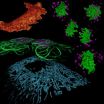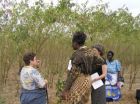(Press-News.org) BOSTON, MA -- Rats can't usually see infrared light, but they have "touched" it in a Duke University lab.
The rats sensed the light as a sensation of touch after Duke neurobiologist Miguel Nicolelis and his team fitted the animals with an infrared detector wired to electrodes implanted in the part of the mammalian brain that processes information related to the sense of touch.
One of the main flaws of current human, brain-controlled prosthetics is that patients cannot sense the texture of what they touch, Nicolelis said. His goal is to give quadriplegics not only the ability to move their limbs again, but also to sense the texture of objects placed in their hands or experience the nuances of the terrain under their feet.
His lab studies how to connect brain cells with external electrodes for brain-machine interfaces and neural prosthetics in human patients and non-human primates, giving them the ability to control limbs, both real and virtual, using only their minds. He and his team have shown that monkeys, without moving any part of their real bodies, could use their electrical brain activity to guide the virtual hands of an avatar to touch virtual objects and recognize their simulated textures.
His latest study, published Feb. 12 in Nature Communications, shows that the rats' cortexes respond both to the simulated sense of touch created by the infrared light sensors and to whisker touch, as if the cortex is dividing itself evenly so that the brain cells process both types of information.
This plasticity of the brain counters the current "optogenetic" approach to brain stimulation, which suggests that a particular neuronal cell type should be stimulated to generate a desired neurological function. Instead, stimulating a broader range of cell types might help a cortical region adapt to new sensory sources, Nicolelis said.
His team recently documented the firing patterns of nearly 2,000 individual, interconnected neurons in monkeys. Recording the electrical activity from thousands of neurons at once is important for improving the accuracy and performance of neuroprosthetic devices, he said.
This brain-machine interface work is all part of an international effort called the Walk Again Project to build a whole-body exoskeleton that could help paralyzed people regain motor and sensory abilities using brain activity to control the apparatus. He and his collaborators expect to first use the exoskeleton in the opening ceremony of the FIFA Soccer World Cup in June 2014.
Nicolelis said infrared sensing might be built into such an exoskeleton so patients wearing the suit could have sensory information about where their limbs are and how objects feel when they touch them.
Nicolelis is a professor of neurobiology, biomedical engineering and psychology and neuroscience at Duke University. He is also founder of Duke's Center for Neuroengineering. He earned his M.D. from the University of Sao Paulo Medical School and his Ph.D. from the Institute of Biomedical Science at the University of Sao Paulo, Brazil.
INFORMATION:
Contact information:
Miguel Nicolelis, M.D., Ph.D.
Associate Professor of Neurobiology
Duke University Medical Center
nicoleli@neuro.duke.edu
Links:
Nicolelis lab: http://www.nicolelislab.net/
TED MED 2012 talk: http://youtu.be/WFzvhZ1qhRg
Book -- Beyond Boundaries: http://www.beyondboundariesnicolelis.net/~beyond/wordpress/
Walk Again Project:
http://www.walkagainproject.org/
Related news:
Neuroprosthesis Gives Rats the Ability to "Touch" Infrared Light
Note: Videos of the experiments and the release are embargoed until 1600 (GMT)/1100 (US EASTERN) Tuesday, Feb. 12, 2013.
Brain Power Moves Virtual Objects
Nearly Two Thousand Brain Cells Recorded at One Time
Publications:
"Perceiving invisible light through a somatosensory cortical prosthesis." Thomson, E. et. al. 2013. Nature Communications. Feb. 12. DOI: 10.1038/ncomms2497
"Active tactile exploration using a brain–machine–brain interface." O'Doherty, J. et. al. 2011. Nature 479, 228�. DOI:10.1038/nature10489
"Mind in Motion." 2012. Sci. Am. 307: 58-63.
"Stochastic Facilitation of Artificial Tactile Sensation in Primates." Medina, L., et. al 2012. J. Neurosci. 32: 14271-14275, 2012. DOI: 10.1523/JNEUROSCI.3115-12.2012
"Reprogramming movements: Extraction of motor intentions from cortical ensemble activity when movement goals change." 2012. Ifft, P., et. al. Front. Neuroeng. 5:16. DOI: 10.3389/fneng.2012.00016
END
BOSTON, MASS.—When difficult biological questions are tackled by creative experts in physics, what can result?
Images of great beauty, accessible for anyone to appreciate, that also offer rich information on fundamental life processes, and rewarding new paths for analysis and insight.
This leading edge of interdisciplinary collaboration in microscopy will be explored in "Innovations in Imaging: Seeing is Believing," Saturday, February 16, 1:30-4:30 PM at the AAAS Annual Meeting in Boston.
The panel will feature three physicists and three biologists, several of ...
CHAMPAIGN, Ill. — Exercise doesn't only strengthen your heart and muscles – it also beefs up your brain. Dozens of studies now show that aerobic exercise can increase the size of critical brain structures and improve cognition in children and older adults.
University of Illinois psychology professor Art Kramer, a nationally recognized expert on the role of physical fitness on cognition, will discuss these brain-changing outcomes at a session of the 2013 meeting of the American Association for the Advancement of Science in Boston on Feb. 16. Kramer is the director of the ...
In his Feb. 12 State of the Union address, President Obama singled out climate change as a top priority for his second administration. "We can choose to believe that Superstorm Sandy, and the most severe drought in decades, and the worst wildfires some states have ever seen were all just a freak coincidence," he said. "Or we can choose to believe in the overwhelming judgment of science – and act before it's too late."
Four years ago, the president addressed rising global temperatures by pledging a 17 percent cut in carbon dioxide (CO2) and other greenhouse gas emissions ...
UNIVERSITY PARK, Pa. -- Hairless skin first evolved in humans as a way to keep cool -- and then turned into a canvas to help them look cool, according to a Penn State anthropologist.
About 1.5 to 2 million years ago, early humans, who were regularly on the move as hunters and scavengers, evolved into nearly hairless creatures to more efficiently sweat away excess body heat, said Nina Jablonski, Distinguished Professor of Anthropology. Later, humans began to decorate skin to increase attractiveness to the opposite sex and to express, among other things, group identity.
"We ...
BOSTON — Through research led by Michigan State University, crop yields have increased dramatically. The children of Ekwendi, Malawi, also have gained weight and are taller. These improvements bring smiles to Sieglinde Snapp, MSU ecologist, and other researchers who have worked in Malawi for many years.
Snapp, a crop and soil scientist at MSU's Kellogg Biological Station, shared the secrets of the initiative's success at the annual meeting of the American Association for the Advancement of Science Feb. 14-18 in Boston.
One of the focal points of her research has been ...
The news sounds grim: mounting scientific evidence indicates climate change will lead to more frequent and intense extreme weather that affects larger areas and lasts longer.
However, we can reduce the risk of weather-related disasters with a variety of measures, according to Stanford Woods Institute Senior Fellow Chris Field.
Field will discuss how to prepare for and adapt to a new climate at the annual American Association for the Advancement of Science (AAAS) meeting in Boston. Field's talk, "Weather Extremes: Coping With the Changing Risks," will be part of a symposium ...
Canine Colors, a subsidiary of True Colors International, features a unique new exhibit at the 4th annual Wisdom 2.0 conference on Feb. 21 through Feb. 24th at the Concourse Exhibition Center in San Francisco, Calif. where thought leaders from business and technology come together to share their insight on how to connect with our non-digital selves and using technology in ways enhance our well-being, making us effective and useful to the world.
"This is a great corporate tool for employee engagement and team building. We want our employees to bring their whole self ...
Stanbridge College, a technical college that offers Masters, Bachelor and Associate of Science degrees and diploma programs in Allied Health and Information Technology, nursing student, Vanessa Gonzalez-Arroyo raised over $6,000 for the Leukemia & Lymphoma Society. The full-time nursing student, worked with in Team in Training, a non-profit organization that trains runners, walkers, triathletes, cyclists and hikers to support cancer research, to participate in two events: a marathon in San Diego and a hike in Yosemite where she raised $2,743 with over 40 donations and ...
Anita Bradfield is a determined single lady, with no car, no savings account, who has found herself in an unusual and difficult situation in life. She is struggling with brain swelling for several years, no health insurance, and in a job economy that makes staying employed longer than a year very difficult. Yes, with brain swelling Anita gets up and goes to work, when work is available. Her attendance at work is as good as her peers, who are healthy. That accomplishment is amazing to pull off, if you live with brain swelling. How do you get up and go to work every day like ...
Today EcoPlum, the green shopping rewards boutique, announces an e-gift cards program, the latest enhancement to its online shopping experience. The gift cards, sent electronically, are an environmentally friendly way to give eco friendly gifts and may be used to buy eco friendly products in the EcoPlum Online Boutique.
Gia Machlin, CEO and Founder of EcoPlum, exclaims, "Holidays are great, but many of us are too busy to come up with the perfect eco friendly gifts for our loved ones on their birthdays, Mother's Day, Valentine's Day or any other occasion. Our new ...


